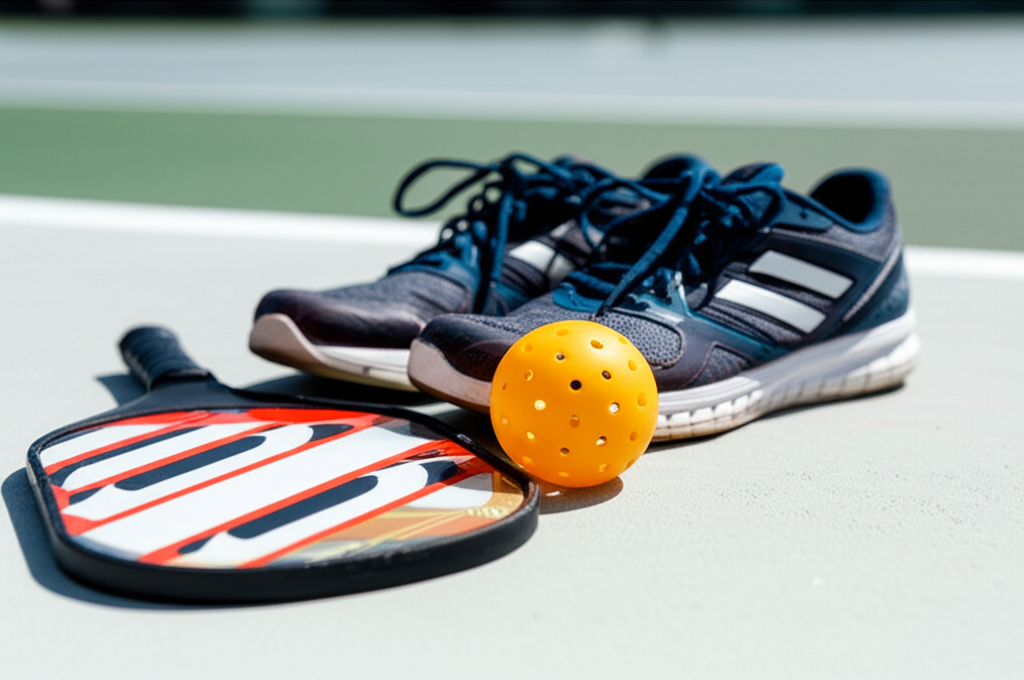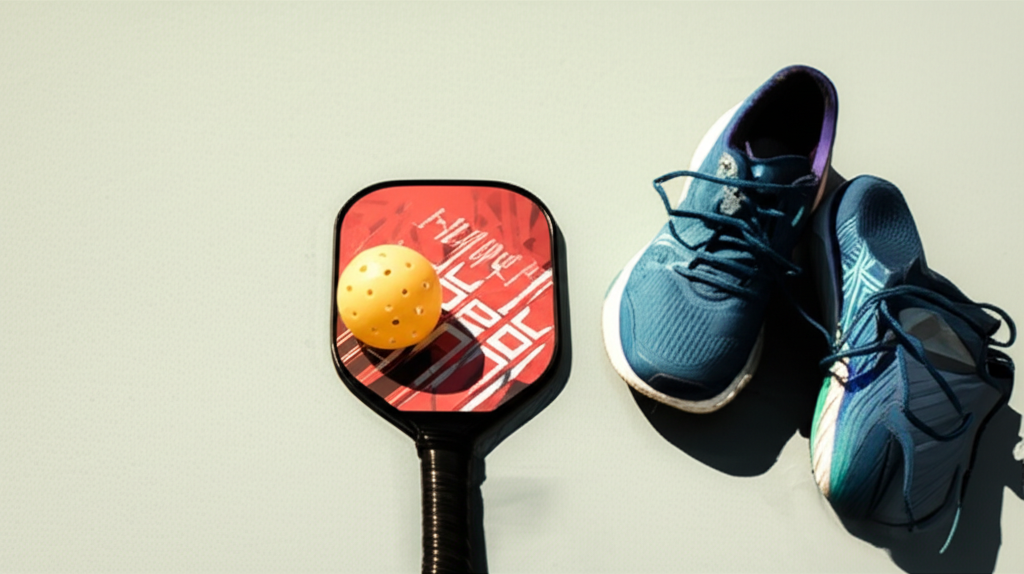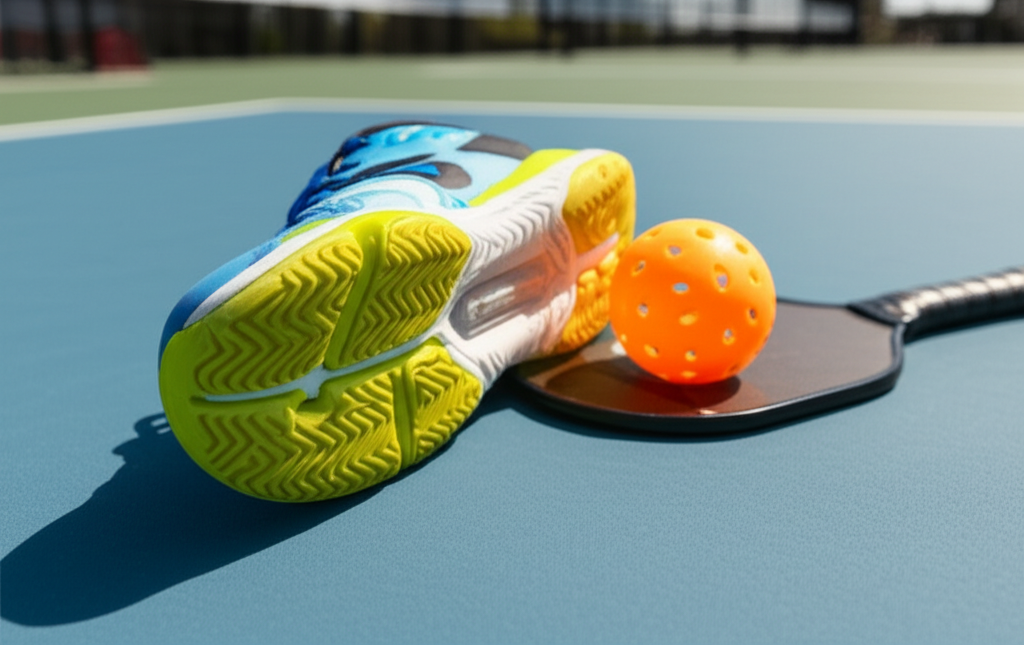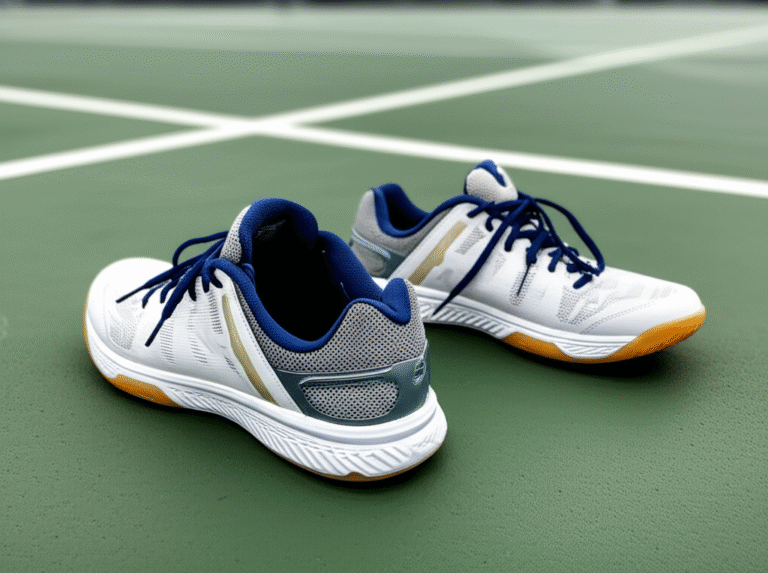Are running shoes good for pickleball? No, they are not ideal. While they offer cushioning, their design lacks the lateral support and multidirectional traction needed for quick pickleball movements, increasing injury risk.
Key Takeaways
- Running shoes lack essential lateral support.
- Pickleball requires multidirectional traction, not just forward grip.
- Court shoes enhance stability and prevent slips.
- Using the wrong shoes can lead to ankle sprains.
- Invest in dedicated pickleball shoes for safety and performance.
- Proper footwear improves comfort and game enjoyment.
Are Running Shoes Good for Pickleball? The Shocking Truth
Stepping onto the pickleball court for the first time is exciting! You’re ready to enjoy the fast-paced fun. But then comes the question: what shoes should you wear? Many beginners reach for their trusty running shoes. After all, they’re comfortable and designed for activity, right? It seems like a sensible choice. However, the truth about using running shoes for pickleball might surprise you. It’s a common question, and understanding the differences between shoe types can save you discomfort and even prevent injuries. Let’s dive into why your running shoes might not be the best choice for dinking and driving on the pickleball court.
Why Your Running Shoes Aren’t Ideal for Pickleball
Running shoes and pickleball shoes are designed with very different movements in mind. Running is primarily a forward motion. Think about it: when you run, you push off your toes and land on your heel, moving in a straight line. Pickleball, on the other hand, involves a lot of side-to-side shuffling, quick stops, starts, and changes in direction. This is where the “shocking truth” comes in – the very features that make running shoes great for running can make them problematic for pickleball.
The Design Differences: Running vs. Pickleball
To understand why, let’s look at the specific design elements of each type of shoe.
Running Shoes: Built for Forward Motion
Running shoes are engineered to absorb impact and provide cushioning for the repetitive forward motion of running. They typically have:
- Ample Heel Cushioning: This is great for shock absorption when your heel strikes the ground repeatedly.
- Flexibility: They are designed to bend easily with your foot as you stride forward.
- Lightweight Construction: To minimize fatigue during long runs.
- Forward Traction: The outsole pattern is usually optimized for grip on pavement or trails during forward movement.
While these features are excellent for logging miles on a track or road, they fall short when you’re on a pickleball court.
Pickleball Shoes: Engineered for Court Agility
Pickleball shoes, also known as court shoes, are specifically designed for the multidirectional movements and quick stops common in sports played on courts like tennis or pickleball. They feature:
- Lateral Support: Sturdy sidewalls and reinforced uppers help prevent your foot from rolling over the edge of the shoe during side-to-side movements.
- Enhanced Traction: Outsoles are designed with patterns that provide grip in all directions, allowing for quick starts, stops, and pivots.
- Durability: The outsoles and uppers are built to withstand the friction and stress of court play.
- Stable Midsole: Offers a good balance of cushioning and support without being overly soft, which could lead to instability.
- Lower Profile: Often have a lower profile than running shoes, which can improve stability by lowering your center of gravity.
The Risks of Wearing Running Shoes for Pickleball
So, what happens when you take those cushioned, flexible running shoes onto the pickleball court? Several risks emerge:
- Increased Risk of Ankle Sprains: Running shoes lack the necessary lateral support. When you make a quick side-to-side movement, your foot can easily roll over the edge of the shoe, leading to a painful ankle sprain. The soft midsole of running shoes can also contribute to instability.
- Poor Traction and Slips: The outsole of a running shoe is designed for forward grip. On a smooth court surface, especially if there’s any dust or moisture, you might find yourself slipping when you try to stop or change direction quickly. This can lead to falls and potential injuries.
- Reduced Agility and Performance: The bulkiness and lack of lateral stability in running shoes can make you feel slower and less agile. You might hesitate to make quick movements, impacting your ability to react to shots and play your best.
- Premature Shoe Wear: The materials in running shoes aren’t built for the constant lateral stress and abrasive contact with court surfaces that pickleball entails. The sides of the shoes can wear out quickly, and the outsoles may become smooth, further reducing traction.
Understanding Pickleball Court Surfaces

The surface you play on also plays a role. Pickleball is typically played on indoor or outdoor courts made of concrete, asphalt, or specialized sports flooring. These surfaces are harder and require different footwear considerations than the softer surfaces (like grass or trails) that some running shoes are designed for.
According to the USA Pickleball Association, proper footwear is crucial for player safety and performance. They emphasize the importance of court shoes that offer stability and traction suitable for the court environment.
What to Look for in Pickleball Shoes
Now that you know why running shoes aren’t the best fit, let’s talk about what makes a great pickleball shoe. When you’re shopping, keep these features in mind:
Essential Pickleball Shoe Features
Here’s a breakdown of what to prioritize:
- Lateral Stability: Look for shoes with reinforced sides and a strong upper that holds your foot securely. This prevents your foot from rolling outwards.
- Non-Marking Outsole with Multi-Directional Tread: This is critical. The tread pattern should offer grip for forward, backward, and side-to-side movements. Most dedicated court shoes will have “non-marking” soles, which is important for indoor courts to avoid leaving scuff marks.
- Durability: The shoe should be constructed with materials that can withstand the rigors of court play, including abrasion from quick stops and starts.
- Comfort and Fit: Even with the right features, the shoe must be comfortable. Ensure a good fit with enough room in the toe box and no pressure points.
- Supportive Midsole: A midsole that offers a balance of cushioning and responsiveness helps absorb shock without sacrificing stability.
Types of Court Shoes for Pickleball
While “pickleball shoes” are becoming more common, you can often use shoes designed for other court sports:
- Tennis Shoes: These are often an excellent choice. Tennis involves a lot of lateral movement, quick stops, and starts, so tennis shoes typically have great lateral support and durable, multi-directional outsoles.
- Squash Shoes: These also offer good lateral support and are designed for quick movements within a smaller court area.
- Badminton Shoes: Similar to squash shoes, they are built for agility on a court.
It’s worth noting that while basketball shoes offer ankle support, they are often heavier and less flexible for the specific quick, shuffling movements of pickleball compared to tennis or dedicated court shoes.
Comparing Shoe Types: A Quick Guide
To make it even clearer, here’s a table comparing the suitability of different shoe types for pickleball:
| Shoe Type | Primary Design Purpose | Suitability for Pickleball | Key Advantages for Pickleball | Key Disadvantages for Pickleball |
|---|---|---|---|---|
| Running Shoes | Forward motion, shock absorption | Poor | Cushioning (limited benefit for court play) | Lack of lateral support, poor multidirectional traction, can lead to slips and sprains. |
| Pickleball Shoes (Dedicated) | Multidirectional court movement, stability, traction | Excellent | Optimal lateral support, excellent traction, durability for court surfaces. | Can be more expensive; availability might be growing but not as widespread as tennis shoes. |
| Tennis Shoes | Lateral movement, quick stops/starts on court | Excellent | Strong lateral support, good multidirectional traction, durable outsoles. | Some models can be heavier; tread patterns might be more aggressive for clay courts (though most are fine for hard courts). |
| Basketball Shoes | Vertical jumping, ankle support, court grip | Fair to Good | Good ankle support, often good court traction. | Can be heavy, less flexible for shuffling movements, may not offer ideal lateral stability for quick side-steps. |
| Cross-Trainers/Gym Shoes | Variety of gym activities, some lateral movement | Fair | Offer more stability than running shoes. | Lateral support and traction may not be specialized enough for intense pickleball play. |
Can You Wear Them in a Pinch?
If you’re just trying pickleball for the very first time and don’t have dedicated court shoes, your running shoes might be better than bare feet or casual sneakers for a single, casual session. However, be extremely cautious. Stick to gentle movements, avoid aggressive cuts and stops, and be aware that you’re at a higher risk for injury. It’s highly recommended to get proper court shoes as soon as possible.
For more insights into athletic footwear, consider resources like the REI guide to getting the right fit, which highlights general principles of shoe comfort and support applicable across different athletic activities.
Finding Your Perfect Pickleball Shoes

Choosing the right pickleball shoes is an investment in your health, comfort, and enjoyment of the game. Don’t let the “shocking truth” about running shoes deter you from pickleball; instead, let it empower you to make a smart footwear choice.
The Importance of Fit
Beyond the specific features, the fit of the shoe is paramount. Here’s how to ensure you get it right:
- Try Them On Later in the Day: Your feet swell throughout the day, so trying on shoes in the afternoon or evening will give you a more accurate fit.
- Wear Your Pickleball Socks: Bring the type of socks you plan to wear while playing to get the most accurate feel.
- Check the Toe Box: You should have about a thumb’s width of space between your longest toe and the end of the shoe. Your toes shouldn’t feel cramped.
- Secure the Heel: Your heel should feel snug and not slip up and down when you walk or perform a few quick movements.
- Walk and Move Around: Don’t just stand there! Walk around the store, do a few side-steps, and pretend to lunge. How do they feel?
- Consider Width: If you have wider feet, look for shoes available in wide sizes or brands known for offering wider options.
Brands and Models to Consider
Many brands offer excellent court shoes suitable for pickleball. While specific models change seasonally, here are some reputable brands known for their quality court footwear:
- ASICS: Often lauded for stability and cushioning, many of their tennis models are great for pickleball.
- New Balance: Known for offering various widths and comfortable fits, their court shoes are popular.
- Nike: Offers a range of athletic shoes, including court shoes with good support and responsiveness.
- Adidas: Another major player with durable court shoes designed for quick movements.
- Skechers: Increasingly offering performance-oriented court shoes that provide good value and comfort.
Always read reviews and, if possible, try shoes on before buying. What works perfectly for one person might not be the best for another, as foot shape and playing style vary.
Pro Tip: When breaking in new court shoes, wear them for shorter play sessions initially. This allows your feet and the shoes to adapt to each other, reducing the risk of blisters or discomfort during longer matches.
Frequently Asked Questions (FAQs)
Q1: Can I wear my old running shoes for pickleball?
While you might be able to play a casual game in old running shoes, it’s not recommended. They lack the necessary lateral support and traction, increasing your risk of ankle sprains and slips. It’s best to switch to dedicated court shoes as soon as possible.
Q2: What’s the main difference between running shoes and pickleball shoes?
Running shoes are designed for forward motion and shock absorption, while pickleball shoes are built for multidirectional movements, offering enhanced lateral support and specific court traction to prevent slips and injuries.
Q3: How do I know if a shoe has good lateral support?
Look for shoes with reinforced sidewalls, a sturdy upper that wraps around your foot securely, and a relatively firm midsole. The shoe should not easily bend or twist sideways. Trying them on and testing side-steps is the best way to feel the support.
Q4: Are tennis shoes good for pickleball?
Yes, tennis shoes are generally an excellent choice for pickleball. They are designed for similar lateral movements, quick stops, and court surfaces, providing the necessary support and traction.
Q5: Will wearing the wrong shoes affect my game?
Absolutely. The wrong shoes can make you feel less stable, slower, and more hesitant to move quickly. This can negatively impact your agility, reaction time, and overall performance on the court. More importantly, it significantly increases the risk of injury.
Q6: How often should I replace my pickleball shoes?
This depends on how often you play and the quality of the shoes, but generally, you should consider replacing them every 6-12 months if you play regularly. Look for signs of wear on the outsole (worn-down tread) and midsole (loss of cushioning or support) as indicators.
Q7: Can I wear my running shoes for walking around the pickleball court before or after a game?
Yes, for casual walking around the venue, your running shoes are perfectly fine. The concern is strictly about wearing them during active pickleball play due to the specific demands of the sport.
Conclusion
The “shocking truth” is that while running shoes are fantastic for their intended purpose, they fall short when it comes to the dynamic, multidirectional demands of pickleball. The lack of lateral support and specialized traction makes them a risky choice, potentially leading to painful injuries like ankle sprains and frustrating slips. By understanding the distinct design differences and prioritizing features like lateral stability and multi-directional grip, you can confidently choose pickleball-specific court shoes. Investing in the right footwear is a simple yet crucial step towards ensuring a safe, comfortable, and enjoyable pickleball experience. So, lace up those proper court shoes and get ready to move with confidence on the pickleball court!


